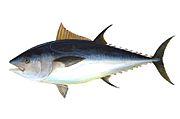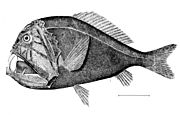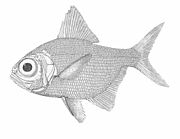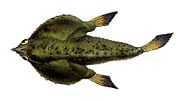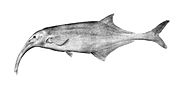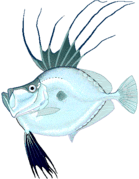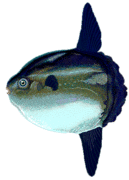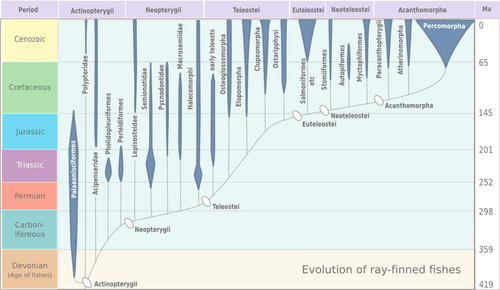Ray-finned fish facts for kids
Quick facts for kids Ray-finned fish |
|
|---|---|
 |
|
| Scientific classification |
|
| Kingdom: | Animalia |
| Phylum: | Chordata |
| Superclass: | Osteichthyes |
| Class: | Actinopterygii Klein, 1885 |
| Subclasses | |
|
|
Actinopterygii ( from [actino-] Error: {{Lang}}: missing language tag (help), meaning 'having rays', and Ancient Greek [πτέρυξ (ptérux)] Error: {{Lang}}: text has italic markup (help), meaning 'wing, fins'), members of which are known as ray-finned fishes, is a clade (traditionally class or subclass) of the bony fishes. They comprise over 50% of living vertebrate species.
The ray-finned fishes are so-called because their fins are webs of skin supported by bony or horny spines (rays), as opposed to the fleshy, lobed fins that characterize the class Sarcopterygii (lobe-finned fish). These actinopterygian fin rays attach directly to the proximal or basal skeletal elements, the radials, which represent the link or connection between these fins and the internal skeleton (e.g., pelvic and pectoral girdles).
By species count, actinopterygians dominate the vertebrates, and they comprise nearly 99% of the over 30,000 species of fish. They are ubiquitous throughout freshwater and marine environments from the deep sea to the highest mountain streams. Extant species can range in size from Paedocypris, at 8 mm (0.3 in), to the massive ocean sunfish, at 2,300 kg (5,070 lb), and the long-bodied oarfish, at 11 m (36 ft). The vast majority of Actinopterygii (~95%) are teleosts.
Contents
Characteristics
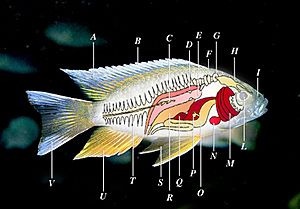
.
Ray-finned fishes occur in many variant forms. The main features of a typical ray-finned fish are shown in the adjacent diagram. The swim bladder is the more derived structure.
Ray-finned fishes have many different types of scales; but all teleosts, the most advanced actinopterygians, have leptoid scales. The outer part of these scales fan out with bony ridges while the inner part is crossed with fibrous connective tissue. Leptoid scales are thinner and more transparent than other types of scales, and lack the hardened enamel or dentine-like layers found in the scales of many other fish. Unlike ganoid scales, which are found in non-teleost actinopterygians, new scales are added in concentric layers as the fish grows.
Ray-finned and lobe-finned fishes, including tetrapods, possessed lungs used for aerial respiration. Only bichirs retain ventrally budding lungs.
Body shapes and fin arrangements
Ray-finned fish vary in size and shape, in their feeding specializations, and in the number and arrangement of their ray-fins.
-
Tuna are streamlined for straight line speed with a deeply forked tail
-
The swordfish is even faster and more streamlined than the tuna
-
Flatfish have developed partially symmetric dorsal and pelvic fins
-
The first spine of the dorsal fin of anglerfish is modified like a fishing rod with a lure
-
The benthic batfish Ogcocephalus notatus
-
Seahorses are in the extended pipefish family
-
The "flying fish" Exocoetus obtusirostris has specialized pectoral fins for gliding
-
The hoodwinker sunfish Mola tecta has no caudal fin
-
The Jurassic †Leedsichthys was a giant filter-feeder
Reproduction

In nearly all ray-finned fish, the sexes are separate, and in most species the females spawn eggs that are fertilized externally, typically with the male inseminating the eggs after they are laid. Development then proceeds with a free-swimming larval stage. However other patterns of ontogeny exist, with one of the commonest being sequential hermaphroditism. In most cases this involves protogyny, fish starting life as females and converting to males at some stage, triggered by some internal or external factor. Protandry, where a fish converts from male to female, is much less common than protogyny.
Most families use external rather than internal fertilization. Of the oviparous teleosts, most (79%) do not provide parental care. Viviparity, ovoviviparity, or some form of parental care for eggs, whether by the male, the female, or both parents is seen in a significant fraction (21%) of the 422 teleost families; no care is likely the ancestral condition. The oldest case of viviparity in ray-finned fish is found in Middle Triassic species of †Saurichthys. Viviparity is relatively rare and is found in about 6% of living teleost species; male care is far more common than female care. Male territoriality "preadapts" a species for evolving male parental care.
There are a few examples of fish that self-fertilise. The mangrove rivulus is an amphibious, simultaneous hermaphrodite, producing both eggs and spawn and having internal fertilisation. This mode of reproduction may be related to the fish's habit of spending long periods out of water in the mangrove forests it inhabits. Males are occasionally produced at temperatures below 19 °C (66 °F) and can fertilise eggs that are then spawned by the female. This maintains genetic variability in a species that is otherwise highly inbred.
Classification and fossil record
Actinopterygii is divided into the classes Cladistia and Actinopteri. The latter comprises the subclasses Chondrostei and Neopterygii. The Neopterygii, in turn, is divided into the infraclasses Holostei and Teleostei. During the Mesozoic (Triassic, Jurassic, Cretaceous) and Cenozoic the teleosts in particular diversified widely. As a result, 96% of living fish species are teleosts (40% of all fish species belong to the teleost subgroup Acanthomorpha), while all other groups of actinopterygians represent depauperate lineages.
The classification of ray-finned fishes can be summarized as follows:
- Cladistia, which include bichirs and reedfish
- Actinopteri, which include:
- Chondrostei, which include Acipenseriformes (paddlefishes and sturgeons)
- Neopterygii, which include:
- Teleostei (most living fishes)
- Holostei, which include:
- Lepisosteiformes (gars)
- Amiiformes (bowfin)
The earliest known fossil actinopterygian is Andreolepis hedei, dating back 420 million years (Late Silurian). Remains have been found in Russia, Sweden, and Estonia. The earliest fossil relatives of modern teleosts are from the Triassic period (Prohalecites, Pholidophorus), although it is suspected that teleosts originated already during the Paleozoic Era.
| Chondrostei | Chondrostei (cartilage bone) is a subclass of primarily cartilaginous fish showing some ossification. Earlier definitions of Chondrostei are now known to be paraphyletic, meaning that this subclass does not contain all the descendants of their common ancestor. There were 52 species divided among two orders, the Acipenseriformes (sturgeons and paddlefishes) and the Polypteriformes (reedfishes and bichirs). Reedfish and birchirs are now separated from the Chondrostei into their own sister lineage, the Cladistia. It is thought that the chondrosteans evolved from bony fish but lost the bony hardening of their cartilaginous skeletons, resulting in a lightening of the frame. Elderly chondrosteans show beginnings of ossification of the skeleton, suggesting that this process is delayed rather than lost in these fish. This group had once been classified with the sharks: the similarities are obvious, as not only do the chondrosteans mostly lack bone, but the structure of the jaw is more akin to that of sharks than other bony fish, and both lack scales (excluding the Polypteriforms). Additional shared features include spiracles and, in sturgeons, a heterocercal tail (the vertebrae extend into the larger lobe of the caudal fin). However the fossil record suggests that these fish have more in common with the Teleostei than their external appearance might suggest. | |
|---|---|---|
| Neopterygii | Neopterygii (new fins) is a subclass of ray-finned fish that appeared somewhere in the Late Permian. There were only few changes during its evolution from the earlier actinopterygians. Neopterygians are a very successful group of fishes because they can move more rapidly than their ancestors. Their scales and skeletons began to lighten during their evolution, and their jaws became more powerful and efficient. While electroreception and the ampullae of Lorenzini is present in all other groups of fish, with the exception of hagfish, neopterygians have lost this sense, though it later re-evolved within Gymnotiformes and catfishes, who possess nonhomologous teleost ampullae. |
Images for kids
-
Fossil of the Devonian †cheirolepidiform †Cheirolepis canadensis
-
Fossil of the Carboniferous †elonichthyiform †Elonichthys peltigerus
-
Fossil of the Permian †aeduelliform †Aeduella blainvillei
-
Fossil of the Permian †palaeonisciform †Palaeoniscum freieslebeni
-
Fossil of the Triassic †bobasatraniiform †Bobasatrania canadensis
-
Fossil of the Triassic †perleidiform †Thoracopterus magnificus
-
Fossils of the Triassic †prohaleciteiform †Prohalecites sp., the earliest teleosteomorph
-
Fossil of the Jurassic †aspidorhynchiform †Aspidorhynchus sp.
-
Fossil of the Jurassic †pachycormiform †Pachycormus curtus
-
Fossil of the Cretaceous acipenseriform †Yanosteus longidorsalis
-
Fossil of the Cretaceous aulopiform †Nematonotus longispinus
-
Fossil of the Cretaceous †ichthyodectiform †Thrissops formosus
-
Fossil of the Cretaceous carangiform †Mene oblonga
-
Fossil of the Cretaceous pleuronectiform †Amphistium paradoxum
-
Fossil of the Miocene syngnathiform †Nerophis zapfei
-
Skeleton of another ray-finned fish, the lingcod
-
Blue catfish skeleton
See also
 In Spanish: Actinopterygii para niños
In Spanish: Actinopterygii para niños


